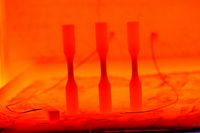Manufacturing Processes
Machining and processing during manufacturing significantly affect the properties of materials during their service periods and represent important research topics at MCL.
Heat treatment plays a crucial role in achieving the final component properties. Consequently, research and development of tailor-made heat treatment process control and its influence on the material properties belongs to the central research topics in the area of materials engineering.
Currently, this field concentrates on the following activities:
- Vacuum heat treatment of highly alloyed steels
- Inductive short-term heat treatment
- Thermochemical near-surface zone modification
- Reduction of residual stress development during hardening
Contacts
In the field of manufacturing processes, MCL's research activities concentrate on the following topics:
Inductive Heat treatment
Inductive heat treatment offers several advantages compared to conventional furnace heat treatment such as shorter processing times. Since the optimum adjustment of the process parameters of the inductive heat treatment is complex, MCL has two facilities for the physical simulation of inductive heat treatment processes. The equipment consists of a laboratory induction unit and a quenching dilatometer with inductive heating.
On the laboratory scale, it is thereby possible to characterise the influences of accelerated heating processes on both microstructure and mechanical properties by means of real, axisymmetric components. In a coupled effort with finite element simulation the process parameters are then evaluated and adapted to adjust the accelerated heat treatment to the regarded material and alternative cross sections.
The most important issues of the current fundamental research activities are the effects of the short interaction times during austenitising and tempering on the development of the microstructure and the resulting mechanical properties of a 50CrMo4 quenched and tempered steel.
Thermochemical Near-Surface Zone Modification
Thermochemical diffusion controlled processes like nitriding enable the increase of both fatigue strength and thermal fatigue resistance. Also the improvement of wear and corrosion resistance are often motivation for the application of a nitriding technique.
MCL's research activities focus on the composition, the structure and the properties of thermochemically enhanced near surface zones in dependence on the applied technique. Special interest is put on highly alloyed steels, e.g. the hot work tool steel X40CrMo5-1.
By the mechanism of precipitation hardening, the finely adjustable plasma nitriding allows for increasing the life time by establishing a hardness gradient and the introduction of compressive residual stresses in the near surface zone. Simultaneously also the wear resistance is improved.
For application-specific adjustment of the edge and for understanding the influence of the alloying elements, a multi-methodical characterisation approach is applied in cooperation with MCL's research partners. Future activities will complement the experimental methods by the application of the thermokinetic simulation software MatCalc for prediction of the precipitate formation.
Reduction of Residual Stress Development During Hardening of Large Components
Due to the thermal inertia of the core regions, management of heat treatment process control related residual stresses is particularly important for large component dimensions. The excess of critical stress levels during oil and water hardening of steels, caused by high temperature gradients, frequently leads to hardening cracks and as a consequence usually to rejection of the whole heat treated batch.
Current research work aims at prevention of the appearance of hardening cracks during quenching of massive die casting moulds and thereby the prolongation of their life time. To this end, multi-phase simulation techniques and models are developed for the prediction of the residual stress development inside the components. The models take the phase transformations upon quenching and the thereby associated transformation induced plasticity (TRIP) into account.
In the same way, MCL performs instrumented heat treatment experiments with correspondingly shaped large specimens to recreate the complex loading situation that occurs during hardening of the moulds. By coupling the results with finite element simulations, critical regions in the component geometry can be identified and the process control during hardening can be customised to achieve a favourable residual stress state.




















![[Translate to Englisch:] Vakuumwärmebehandlung](/fileadmin/_processed_/8/4/csm_WkstBearbeitung-Prozessfuehrung_Bild_3_ef950b7bb3.jpg)
![[Translate to Englisch:] Induktive Härtung von Stabmaterial](/fileadmin/_processed_/5/e/csm_03_Spule_AVi_6fe6a0e0a6.jpg)
![[Translate to Englisch:] Plasmanitrieren](/fileadmin/_processed_/4/2/csm_Plasmanitrieren_Bild_1_0544efa8d7.jpg)
![[Translate to Englisch:] EFTEM-Verteilungsbilder einer nitrierten Randzone](/fileadmin/_processed_/4/0/csm_Fig_5_338776e657.jpg)
![[Translate to Englisch:] Wärmebehandlung große Druckgußform](/fileadmin/_processed_/c/6/csm_WBH_grosse_Werkzeuge_Bild_2_3a800e4320.jpg)
![[Translate to Englisch:] Berechnete Spannungsverteilung in einem Bauteil beim Abschrecken (Härten)](/fileadmin/_processed_/5/9/csm_Spannungsoptimierung_Bild_2_4663387609.jpg)